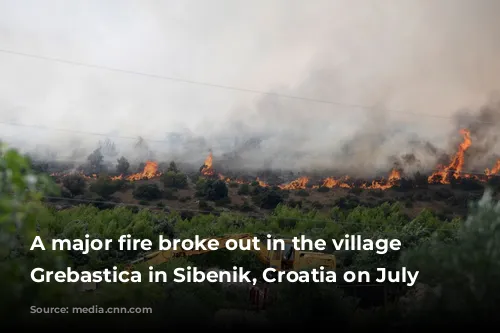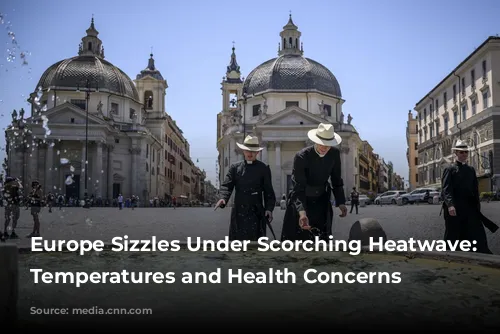A blistering and deadly heatwave is gripping Europe, pushing temperatures to record-breaking levels and raising serious concerns about the health of residents and tourists alike.
This intense heatwave, nicknamed “Cerberus” by the Italian Meteorological Society, is bringing sweltering temperatures across Spain, France, Greece, Croatia, and Italy. Temperatures are soaring above 40 degrees Celsius (104 Fahrenheit) in many regions, sparking fears of heatstroke and other heat-related illnesses.
This scorching heatwave, unfortunately, coincides with the peak of Europe’s summer tourism season, making it even more dangerous for visitors.

Tourist Destinations Under Siege
Italy is expected to be hit particularly hard by this heatwave. Temperatures in Sardinia and Sicily could approach the current European temperature record of 48.8 degrees Celsius (nearly 120 Fahrenheit), according to the European Space Agency. The Italian Health Ministry has issued an “extreme” health risk warning for 15 cities, including Rome and Florence, urging residents and tourists to take precautions.
The heatwave has already claimed at least one life in Italy. A 44-year-old road construction worker succumbed to the heat in Lodi, northern Italy, after collapsing on Tuesday. In Rome, several tourists have fainted due to heatstroke, including one British tourist who passed out in front of the Colosseum. Alessandro Miani, president of the Italian Society of Environmental Medicine, sadly stated that Italy has the highest number of heatwave-related deaths in Europe.
In Greece, temperatures are expected to reach 44 degrees Celsius (111.2 Fahrenheit) on Friday or Saturday. The Acropolis in Athens will be closed from midday to 5 p.m. on Friday due to the extreme heat. Police are assisting tourists who are struggling with the heat, such as a female tourist who was in difficulty at the Acropolis.
Croatia is battling a wildfire near Grebastica, a small town near Sibenik. Dozens of firefighters and aerial firefighting planes are working to contain the blaze, which has already destroyed cars and homes in the town. The area around Grebastica is currently without electricity.
A Global Heatwave
Europe is not alone in facing this extreme heat. A dangerous heatwave is also affecting parts of the Western United States, impacting more than 90 million people. California’s Death Valley, known as the hottest place on Earth, could reach 54.4 degrees Celsius (130 Fahrenheit) on Sunday.
The combination of human-caused climate change and the arrival of El Niño, a natural climate phenomenon with a global heating effect, is driving these record-breaking temperatures. Last month was the warmest June on record globally, and last week the planet experienced its hottest day ever recorded.
The Silent Killer: Understanding Heatstroke
Heat is often called a “silent killer” because its dangers are often underestimated. While you can’t see it, it can quickly turn deadly, especially for vulnerable groups such as the very young, the elderly, outdoor workers, and people experiencing homelessness.
Our bodies are accustomed to a temperature range between 36 to 37 degrees Celsius (97 to 99 degrees Fahrenheit). When temperatures rise above this range, our bodies sweat to cool down. However, the higher the temperature, the more difficult it becomes for our bodies to cool down, especially in humid conditions where sweat cannot evaporate easily.
Heat exhaustion can occur when our bodies overheat, leading to dizziness, nausea, and headaches. Heatstroke is a more severe condition that occurs when the body’s temperature rises to 40 degrees Celsius (104 Fahrenheit) or higher. If left untreated, heatstroke can damage organs and even lead to death.
Staying Safe in the Heat
To protect yourself from the heat, experts recommend staying indoors during the hottest parts of the day, especially between 11 a.m. and 3 p.m. If you must go outside, stay in the shade, wear light loose-fitting clothing, a hat, and sunscreen. Drink plenty of water, even if you don’t feel thirsty, and avoid alcohol and caffeinated drinks.
It’s also crucial to watch out for others, especially those who may be more vulnerable to the heat. If someone starts feeling light-headed, dizzy, nauseous, or experiences a headache, seek immediate medical attention. Get them out of the heat and into a cool environment as quickly as possible.
As the climate crisis intensifies, these record-breaking heatwaves are only expected to become more frequent and severe. It’s essential to understand the dangers of extreme heat and take precautions to stay safe.
